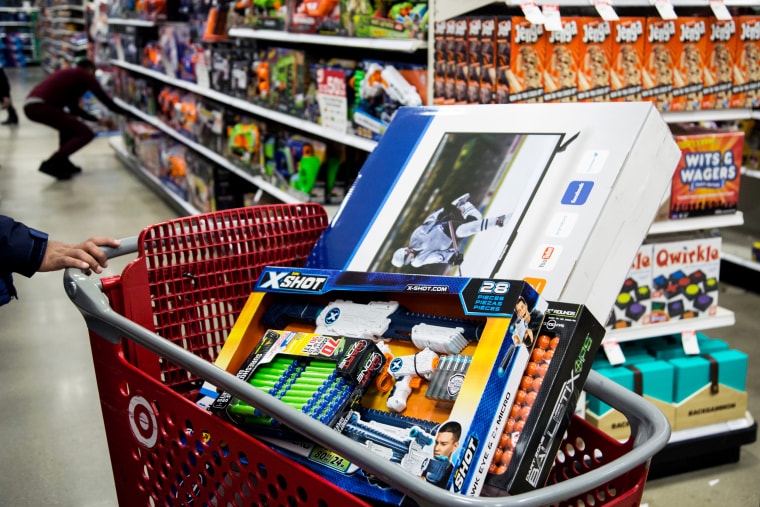Walmart, Amazon, and Target are battling for the $7 billion gap in the toy market left by Toys R Us, which liquidated last year. But it could ultimately be a quirk of the calendar that decides who prevails this year.
The fight for toy sales is a complicated one, as consumers become more comfortable buying toys online -- but still visit stores to sample them.
As online sellers such as Amazon continue to compete on convenience and assortment, brick-and-mortar stores are leveraging their physical footprint to lure in shoppers with Instagrammable displays and events. With the U.S. toy industry reaching $28 billion this year, there is a lot at stake for top retailers.
“The retailers are in the right place and products are in the right place,” said Steve Pasierb, president and CEO of the trade group The Toy Association. “It’s just people coming to the store and buying -- that is the great unknown.”
Amazon, Target, and Walmart have all dramatically increased their toy assortment this year, adding marketing bells and whistles to dazzle shoppers. Walmart holds the largest toy sale market share, at 23.1 percent, according to the research firm IBISWorld, and has recently doubled down on efforts to bridge the divide between digital and online toy shopping.
Walmart expanded its range of exclusive toy products and added 40 new toys from kid-influencer brands for this holiday season. It released a curated hot toy list and dropped prices on more than 200 toys in stores and online.
But it has taken its competitive edge on price up a notch with the launch of its online Toy Lab in partnership with the video developer company Eko. The lab lets kids see and test out new products online in an interactive video format. The company has also rolled out “retailtainment” events where kids and families are invited to in-store toy demonstrations or scavenger hunts that teach kids where top toys are located in the store.
“When customers can touch and feel it and see how [a new toy] works and see kids interacting with it, it helps the parents to see how into it the kids really are," said Anne Marie Kehoe, Walmart's vice president of toys. "What we’re trying to do is bring stuff to life.”
Target is also positioning itself for the long game in toys. Last year, stores added nearly a quarter-million square feet of toy space across 500 locations, nearly doubled its toy inventory, and digitized its toy gift catalog. This year it dedicated space across 25 locations for a Disney Store, where kids and families are invited to watch Disney movies, play with toys, and pose for photos with a lightsaber or a prince or princess crown. Tru Kids Brands, the new parent of Toys R Us, partnered with Target to power its online sales and fulfillment: Shoppers who want to buy a toy on the Toys R Us website are re-directed to Target for purchase and fulfillment.
“We're well prepared in those categories with a number of new and exclusive items,” Brian Cornell, Target’s CEO, told investors last week. "So I think we're in a terrific position as we get ready for the upcoming weeks. And particularly from an electronics, toy and seasonal standpoint, I think we're going to stand tall.”
Online remains the leading shopping destination for consumers, with mass merchants second, according to Deloitte’s retail holiday survey released this month. More than half -- 54 percent -- of shoppers prefer online shopping over in-store purchases during the holiday season, particularly for electronics and toys.
Amazon is positioning itself to grab those dollars. Shoppers can now expect their toys to arrive at their homes even sooner, with the rollout of Amazon’s one-day shipping. Aside from shipping speed, Amazon also has an edge when it comes to assortment. It launched its biggest toy list yet, featuring more than 1,700 top products from top brands with a total of 26,000 new and exclusive toys from brands such as Marvel, Star Wars, Harry Potter, PJ Masks and Paw Patrol. Its toy catalog this year features QR codes that directly link to Amazon product listings, a sticker sheet to tag wishlist items, and space for kids to write their own wishlist. The catalog adds a level of discovery where Amazon is at a disadvantage, Jackie Breyer, editorial director of The Toy Insider, told NBC News.
“When people go to Amazon they know what they’re looking for,” she said. “The catalog intuitively connects consumers from the page to the site. It gives Amazon something a little different to put in consumer hands.”
Brick-and-mortar retailers may have an edge over Amazon with last-minute shoppers this year, since there are six fewer days than normal between Thanksgiving and Christmas, said Juli Lennett, vice president and industry adviser for toys with research firm The NPD Group.
The last time shoppers had less time between Thanksgiving and Christmas, sales surged in the final week of the holiday season for the toy industry. The NPD Group expects even more sales this year than last year — upwards of $280 million in growth — and a bigger share of that may be spent in stores.
"If the brick-and-mortar retailers can maintain inventory during the week of Christmas, and consumers are concerned about buying online and not having their gift arrive in time, it is a great opportunity for brick-and-mortar to capitalize on these sales from last-minute shoppers and gain some portion of that share gain the week of Christmas,” she said.
